POW Installs First Vanadium Battery in Australia
Hey! Looks like you have stumbled on the section of our website where we have archived articles from our old business model.
In 2019 the original founding team returned to run Next Investors, we changed our business model to only write about stocks we carefully research and are invested in for the long term.
The below articles were written under our previous business model. We have kept these articles online here for your reference.
Our new mission is to build a high performing ASX micro cap investment portfolio and share our research, analysis and investment strategy with our readers.
Click Here to View Latest Articles
Protean Energy (ASX:POW) has been hard at work recently, with several news breaking announcements.
Whilst each announcement, which we will cover in more detail shortly, is worthy of serious attention, it’s POW’s latest news that is sure to put this early stage vanadium explorer further in the spotlight.
This week, POW announced the installation of a 25kW (100kWh) V-KOR vanadium battery at the site of OzLinc Industries in O’Connor (Perth Western Australia). The battery will be used in a micro grid situation — isolated from the main electrical grid — in combination with a 21kW solar PV system and a 21kW diesel generator.
The micro grid trial at OzLinc is designed to demonstrate how the V-KOR battery operates as part of an off-grid solution in commercial/industrial premises.
The installation comes at a time when vanadium is in sharp focus as a choice metal, particularly in vanadium redox flow batteries (VRFB), which many believe could be a superior way of storing grid energy than lithium-ion.
It is no surprise then that the vanadium price has risen by more than 50% since the start of the year and is up 175% in the last 12 months with little sign of slowing down.
Although it should be noted that commodity prices do fluctuate and investors interested in today’s stock should take all publicly available information into account before making an investment decision.
POW is looking to capitalise on these conditions and through a $120,000 grant has taken the opportunity to fast track the development and testing of its V-KOR range of vanadium redox flow batteries, specifically the 5kW/100kWh vanadium V-KOR battery that is currently being trialled in Western Australia.
You may remember from our last article ASX Vanadium Junior: A Unique Exposure to the Next Energy Metal, that POW is delineating what could be a world-class vanadium deposit at its Daejon Project in South Korea.
Daejon is a multi‐mineral project that POW has access to through its 50% holding in Stonehenge Korea Limited (SHK). The other 50% is held by DST Company Limited which was recently reinstated on South Korea’s stock exchange boosting the value of POW’s shareholding in its joint venture partner.
Through this JV, POW also owns a part share of a battery factory in South Korea that gives it an end-to-end production to processing pathway.
On the exploration front, POW is also moving forward at pace having announced the completion of a 3D geological modelling program — stage 1 p-XRF testing — of the Daejon vanadium deposit, paving the way for an interim Mineral Resource in the second quarter of 2018.
Notably, modelling to date has identified another black shale horizon that could host additional vanadium mineralisation. What is known is that its assets are unique sediment hosted vanadium deposits, potentially suited to produce the high-purity vanadium pentoxide (V2O5) required for VRFBs.
The vertical integration between POW’s downstream vanadium resource at the Daejon Project in Korea and the vanadium V-KOR battery differentiates POW from its peers in the battery minerals sector.
Certainly, POW look to have all its ducks in a row as it swings into the second half of 2018 with its tail up and an updated Mineral Resource Estimate due imminently.
So let’s get into the nitty gritty of POW’s latest news and reconnect with...
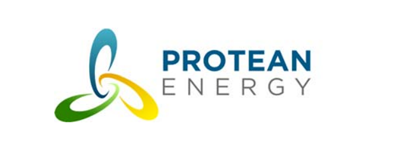
The vertical integration between its downstream vanadium resource and the vanadium V-KOR battery, puts Protean Energy (ASX:POW) in a position of significant strategic advantage in the rapidly expanding battery storage market.
Here’s a look at its assets, which should give you an idea of the kind of foothold this company has in the vanadium space and why it could one day be a major player in the energy storage market:
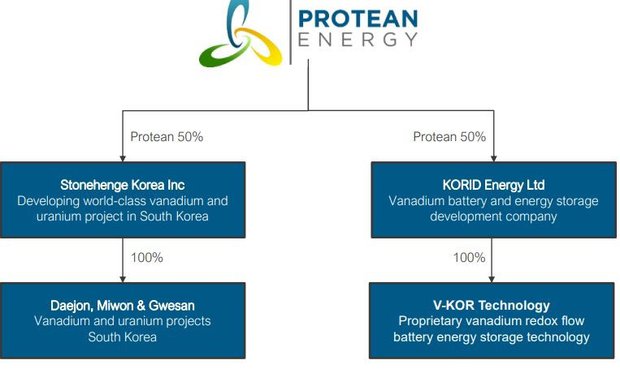
According to Bloomberg New Energy Finance, we will see investments up to A$136 billion in energy storage by 2030.
Headlines like the one from the Sydney Morning Herald tell the positive tale:

Here’s a look at the US energy storage market to 2021, which tells us that energy deployment is forecast to reach 2045 megawatts in the US in 2021:

That increase is a global trend:
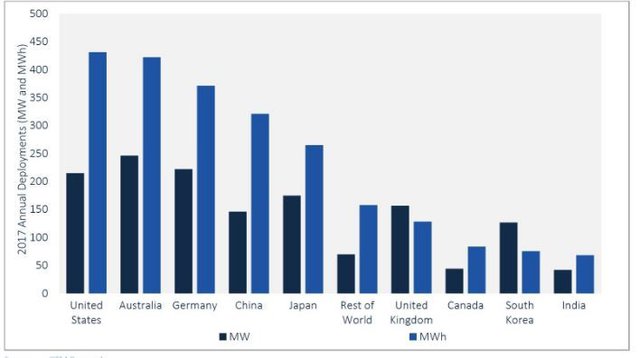
POW operates in South Korea, a developed economy with the advantages of cheap nuclear power, rail, road, access to major population centres and a stable political system that is supportive of overseas mining investment.
Its proximity to China is also important as China’s scrap import ban at the end of 2017 was designed to cut approximately 4,500-5,500 tonnes from the country’s vanadium pentoxide (V2O5) production per year. Regulations in China pertaining to the strength of its steel could also see vanadium consumption increase by 30%, or 10,000 tonnes per year.
In other words, POW is very well placed not only regionally, but commercially. Now, with the first deployment and micro grid integration for its V-KOR battery under its wing, this vertically integrated vanadium company could really start to fly high.
POW steps up with first Australian deployment
The V-KOR energy system could have immediate long term benefits if the latest announcement is anything to go by.
For those unfamiliar with the technology, V-KOR is a proprietary ‘Vanadium Redox Flow Battery Energy Storage System (VRFB-ESS)’, developed to meet rapidly growing demand for more efficient energy storage solutions.
Ownership of KORID Energy, the company behind V-KOR is shared between POW and DST:
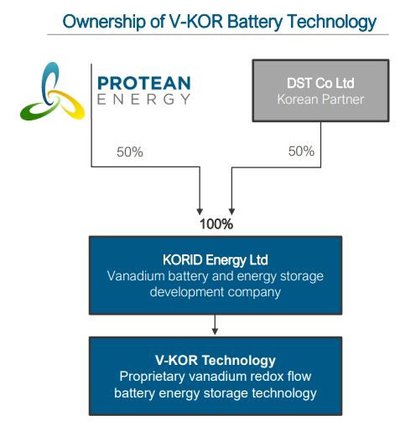
V-KOR has been developed over the past five years with patents granted to protect the design. Four stack sizes of flow batteries have been developed to date including a 2.5kW, 5kW, 10kW and 25kW units to provide commercial options to customers with varying energy storage needs. VRFBs can be scaled up to provide large power (1-5 MW) storage units with energy capacity simply increased by electrolyte volume.
Here’s a look at 5kW under test (LHS) at POW affiliate PROKOR's facility and the 50kW unit being tested at KCL (RHS).

And here’s a look at 50kW/200kWh unit being tested at the Korean Conformity Laboratories (KCL) in conjunction with a 20kW solar array. This test has been in progress for many months and will continue for the foreseeable future to provide invaluable information concerning the product development for the commercial production models.

VKOR is a commercial-ready solution, built-to-order for commercial, industrial and grid-scale applications, and has been designed by the JV to be fully scalable — offering solutions from 2kW to 20MW and larger to suit a customer’s specific requirements.
It is that fact that makes this first Australian deployment so important as the company, its shareholders and the general public gain a broader understanding of just how powerful this technology could be in future.
Of course, today’s junior stock remains a speculative play at this stage and investors should seek professional financial advice if considering this stock for their portfolio.
The installation of the V-KOR vanadium battery at the OzLinc Industries site, will demonstrate how the battery can be used in a micro-grid scenario (isolated from the main electric grid) in commercial/industrial premises. The 25kW (100kWh) battery will be used in combination with a 21kW solar PV system and a 21kW diesel generator.
OzLinc is a supplier of pipe, fittings, flanges, valves and hosing to the Australian marine, industrial and resources sectors. The trial will facilitate collection of representatives operating data for the battery, demonstrate charging operation using grid and solar supply and will demonstrate automatic system power stabilisation characteristics given a fluctuating solar supply.
Here’s a look at KORID technicians overseeing the installation of the V-KOR battery:
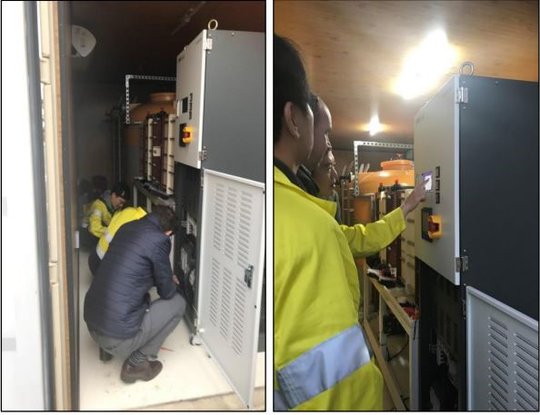
The micro grid demonstration represents the first phase of a two phase Australian trial, with the next phase designed to incorporate the integration of the solar system and the V-KOR battery into the Western Power electricity grid.
The following picture indicates the incorporation of the solar system:
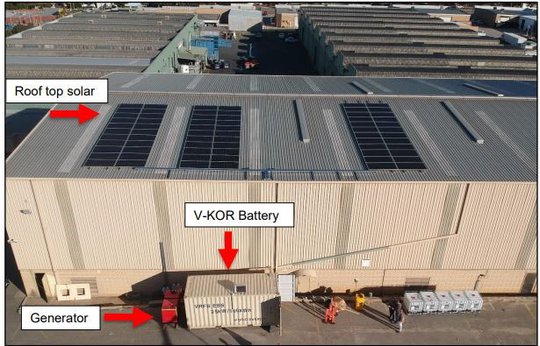
It is expected that the V-KOR battery will be proven as a key renewable energy enabler, used in conjunction with multiple energy systems including solar, wind and natural gas generators.
It will also enable customers to store energy when it is available from the grid at off peak rates or when a solar system or wind farm is generating power for free. For remote customers operating off the electricity network this is a very valuable advantage.
The V-KOR battery is now progressing towards full commercialisation as POW looks to capitalise on the rapidly expanding global battery market.
Why V-KOR?
Perhaps the question should be: why not?
When you look at the key advantages, it is little wonder POW’s technology is gaining traction.
- Highly scalable and therefore suitable for large projects and grid storage
- Ability to retain high levels of charge for longer periods
- Long life-span (20 years+)
- Release of energy can be instant
- 100% depth of discharge
- Proven to operate at high ambient temperatures
- Electrolytes are non-flammable and therefore inherently safe
- Best life cycle value energy storage system
So, how does it work? Let’s look at it in more detail.
The V-KOR systems are a type of rechargeable flow battery that employs vanadium ions in different oxidation states to store energy in the form of two liquid electrolytes.
Here’s how a VRFB works:
VRFBs, which are proven to have excellent durability and life spans of at least 15-20 years, have an energy capacity independent of the power rating allowing the storage system to be designed for highly specific energy and power requirements. This fact alone makes it well suited to applications with large energy capacity specifications.
These batteries are currently used for grid scale energy storage applications where large-scale and long duration electrical energy storage is required and are an ideal solution for growing renewable energy generation sources such as solar and wind.
On the exploration front
The battery division of the business is highly important for POW, and having an asset that is already in commercialisation phase puts the company in a strong position to meet its downstream ambitions.
Its partnership with DST is crucial to moving the battery side of the business forward, but the exploration side is just as important. POW holds approximately $3.1 million in cash, in addition to its A$2.4 million shareholding in DST, placing it in a solid financial position to advance the Daejon Vanadium Project alongside its V-KOR vanadium battery technology.
So let’s have a look at the project.
On April 24, POW announced that a 3D geological modelling program — stage 1 p-XRF testing — of the Daejon vanadium deposit in Korea would be completed within days. The program paves the way for an interim Mineral Resource in the second quarter of 2018.
The announcement was reported by Finfeed.com (a related entity of S3 Consortium Pty Ltd as defined in Section 9 of the Corporations Act 2001):
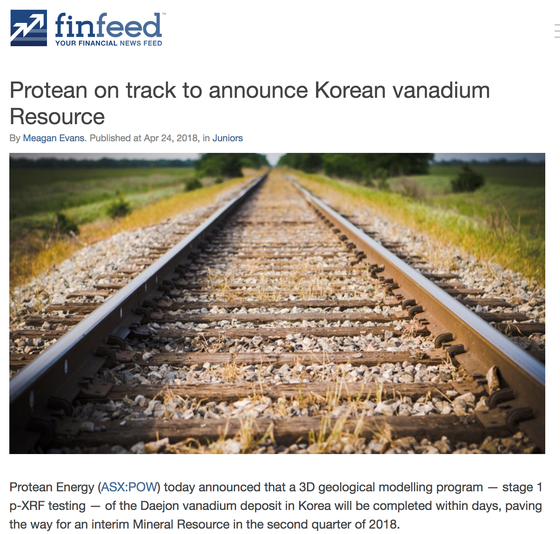
That modelling has now been completed and POW has extensively modified the existing black shale horizons. Below you can see the extra black shale horizon identified from the existing geological data which is expected to host additional vanadium mineralisation, as seen on the cross section below.
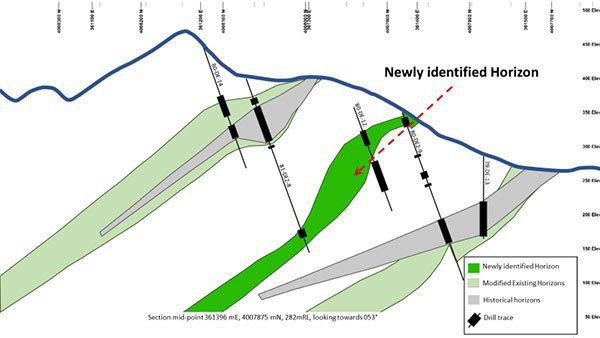
Here’s a look at POW’s projects in the region, including Daejon.
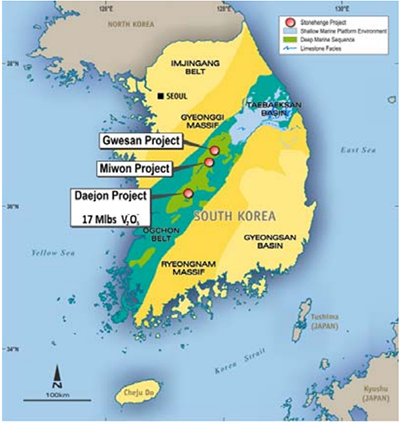
An interim Mineral Resource estimate will commence over approximately 40% of the known strike length which will have p-XRF readings over mineralised intercepts. The interim Resource estimate will be available later this year (Q2 2018) and a final Mineral Resource estimate will be undertaken once Stage 2 of the p-XRF testing program is complete.
Back in January, POW completed an orientation program which proved the viability of using p-XRF assay methods in informing a JORC 2012 vanadium Resource at the Daejon project. POW then secured access to conduct non-destructive testing of the 36,000 metres of historical core held by the Korean Institute of Geosciences (KIGAM) and commenced testing. 42 high priority holes totalling 2344m of mineralised core approaching completion were tested.
POW will now commence a Stage 2 p-XRF sampling program to test 35 holes totalling 2315m of mineralised core. Once Stage 2 is completed, the planned final Mineral Resource update will be available in the third quarter of 2018.
Peer to peer
Given what it has in its bag, POW sits nicely amongst its peers as a company with a great deal of upside.
As you can see by the table below, the fact that it has a sediment hosted deposit and is vertically integrated really does set POW apart.
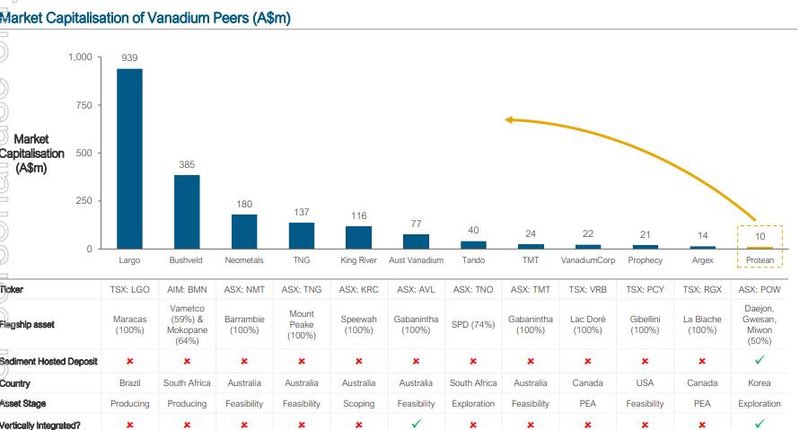
With a raft of news flow to come, there's reason to believe that POW's market cap could begin to rival that of its peers.
Of course there’s no guarantee that POW will replicate the success of its peers, so investors should seek professional financial advice if considering this stock for their portfolio.
Looking forward
There is a great deal of news flow expected from POW on both the battery and exploration fronts.
Installation of its V-KOR battery in Western Australia is to be completed this month, along with release of Western Australia V-KOR battery trial terms and the results of the trial in the second half of the 2018 financial year.
As for news from Daejong, we can look forward to the completion of Stage 1 of KIGAM pXRF test work, and Interim vanadium Mineral Resource; results from tests targeting high purity V2O5 precipitate in mid-June; a JORC-compliant vanadium and uranium Resource over the entire 8300m of estimated mineralisation strike length by Q3; commencement of vanadium offtake partner discussions in H2 2018; and commencement of a PFS at Daejon in early 2019.
Given that amount of news flow, expectations are high for this vanadium junior, particularly as the vanadium and high tech battery markets continue to grow at a rapid pace.
General Information Only
This material has been prepared by StocksDigital. StocksDigital is an authorised representative (CAR 000433913) of 62 Consulting Pty Limited (ABN 88 664 809 303) (AFSL 548573).
This material is general advice only and is not an offer for the purchase or sale of any financial product or service. The material is not intended to provide you with personal financial or tax advice and does not take into account your personal objectives, financial situation or needs. Although we believe that the material is correct, no warranty of accuracy, reliability or completeness is given, except for liability under statute which cannot be excluded. Please note that past performance may not be indicative of future performance and that no guarantee of performance, the return of capital or a particular rate of return is given by 62C, StocksDigital, any of their related body corporates or any other person. To the maximum extent possible, 62C, StocksDigital, their related body corporates or any other person do not accept any liability for any statement in this material.
Conflicts of Interest Notice
S3 and its associated entities may hold investments in companies featured in its articles, including through being paid in the securities of the companies we provide commentary on. We disclose the securities held in relation to a particular company that we provide commentary on. Refer to our Disclosure Policy for information on our self-imposed trading blackouts, hold conditions and de-risking (sell conditions) which seek to mitigate against any potential conflicts of interest.
Publication Notice and Disclaimer
The information contained in this article is current as at the publication date. At the time of publishing, the information contained in this article is based on sources which are available in the public domain that we consider to be reliable, and our own analysis of those sources. The views of the author may not reflect the views of the AFSL holder. Any decision by you to purchase securities in the companies featured in this article should be done so after you have sought your own independent professional advice regarding this information and made your own inquiries as to the validity of any information in this article.
Any forward-looking statements contained in this article are not guarantees or predictions of future performance, and involve known and unknown risks, uncertainties and other factors, many of which are beyond our control, and which may cause actual results or performance of companies featured to differ materially from those expressed in the statements contained in this article. S3 cannot and does not give any assurance that the results or performance expressed or implied by any forward-looking statements contained in this article will actually occur and readers are cautioned not to put undue reliance on forward-looking statements.
This article may include references to our past investing performance. Past performance is not a reliable indicator of our future investing performance.

